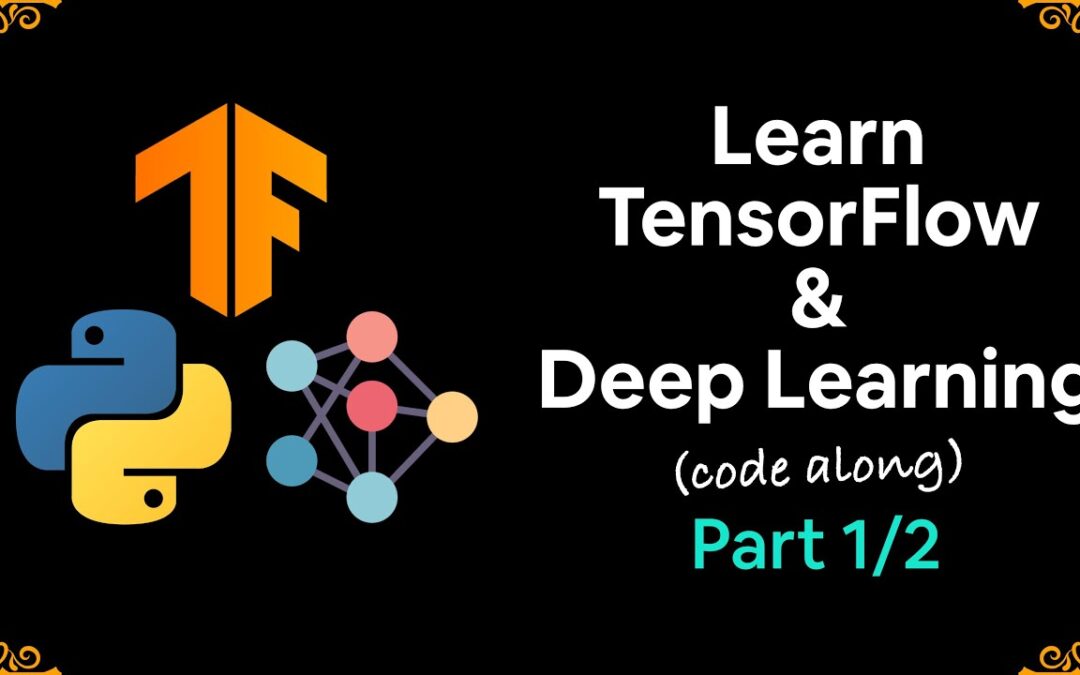The Videos are copyrighted to YouTube and the author. The videos are reproduced here for the easy access by the viewers.
Ready to learn the fundamentals of TensorFlow and deep learning with Python? Well, you’ve come to the right place.
After this two-part code-first introduction, you’ll have written 100s of lines of TensorFlow code and have hands-on experience with two important problems in machine learning: regression (predicting a number) and classification (predicting if something is one thing or another).
Open a Google Colab (if you’re not sure what this is, you’ll find out soon) window and get ready to code along.
Sign up for the full course – https://dbourke.link/ZTMTFcourse
Get all of the code/materials on GitHub – https://www.github.com/mrdbourke/tensorflow-deep-learning/
Ask a question – https://github.com/mrdbourke/tensorflow-deep-learning/discussions
See part 2 – https://youtu.be/ZUKz4125WNI
TensorFlow Python documentation – https://www.tensorflow.org/api_docs/python/tf
Connect elsewhere:
Web – https://www.mrdbourke.com
Livestreams on Twitch – https://www.twitch.tv/mrdbourke
Get email updates on my work – https://www.mrdbourke.com/newsletter
Timestamps:
0:00 – Intro/hello/how to approach this video
1:50 – MODULE 0 START (TensorFlow/deep learning fundamentals)
1:53 – [Keynote] 1. What is deep learning?
6:31 – [Keynote] 2. Why use deep learning?
16:10 – [Keynote] 3. What are neural networks?
26:33 – [Keynote] 4. What is deep learning actually used for?
35:10 – [Keynote] 5. What is and why use TensorFlow?
43:05 – [Keynote] 6. What is a tensor?
46:40 – [Keynote] 7. What we’re going to cover
51:12 – [Keynote] 8. How to approach this course
56:45 – 9. Creating our first tensors with TensorFlow
1:15:32 – 10. Creating tensors with tf Variable
1:22:40 – 11. Creating random tensors
1:32:20 – 12. Shuffling the order of tensors
1:42:00 – 13. Creating tensors from NumPy arrays
1:53:57 – 14. Getting information from our tensors
2:05:52 – 15. Indexing and expanding tensors
2:18:27 – 16. Manipulating tensors with basic operations
2:24:00 – 17. Matrix multiplication part 1
2:35:55 – 18. Matrix multiplication part 2
2:49:25 – 19. Matrix multiplication part 3
2:59:27 – 20. Changing the datatype of tensors
3:06:24 – 21. Aggregating tensors
3:16:14 – 22. Tensor troubleshooting
3:22:27 – 23. Find the positional min and max of a tensor
3:31:56 – 24. Squeezing a tensor
3:34:57 – 25. One-hot encoding tensors
3:40:44 – 26. Trying out more tensor math operations
3:45:31 – 27. Using TensorFlow with NumPy
3:51:14 – MODULE 1 START (neural network regression)
3:51:25 – [Keynote] 28. Intro to neural network regression with TensorFlow
3:58:57 – [Keynote] 29. Inputs and outputs of a regression model
4:07:55 – [Keynote] 30. Architecture of a neural network regression model
4:15:51 – 31. Creating sample regression data
4:28:39 – 32. Steps in modelling with TensorFlow
4:48:53 – 33. Steps in improving a model part 1
4:54:56 – 34. Steps in improving a model part 2
5:04:22 – 35. Steps in improving a model part 3
5:16:55 – 36. Evaluating a model part 1 (“visualize, visualize, visualize”)
5:24:20 – 37. Evaluating a model part 2 (the 3 datasets)
5:35:22 – 38. Evaluating a model part 3 (model summary)
5:52:39 – 39. Evaluating a model part 4 (visualizing layers)
5:59:56 – 40. Evaluating a model part 5 (visualizing predictions)
6:09:11 – 41. Evaluating a model part 6 (regression evaluation metrics)
6:17:19 – 42. Evaluating a regression model part 7 (MAE)
6:23:10 – 43. Evaluating a regression model part 8 (MSE)
6:26:29 – 44. Modelling experiments part 1 (start with a simple model)
6:40:19 – 45. Modelling experiments part 2 (increasing complexity)
6:51:49 – 46. Comparing and tracking experiments
7:02:08 – 47. Saving a model
7:11:32 – 48. Loading a saved model
7:21:49 – 49. Saving and downloading files from Google Colab
7:28:07 – 50. Putting together what we’ve learned 1 (preparing a dataset)
7:41:38 – 51. Putting together what we’ve learned 2 (building a regression model)
7:55:01 – 52. Putting together what we’ve learned 3 (improving our regression model)
8:10:45 – [Code] 53. Preprocessing data 1 (concepts)
8:20:21 – [Code] 54. Preprocessing data 2 (normalizing data)
8:31:17 – [Code] 55. Preprocessing data 3 (fitting a model on normalized data)
8:38:57 – MODULE 2 START (neural network classification)
8:39:07 – [Keynote] 56. Introduction to neural network classification with TensorFlow
8:47:31 – [Keynote] 57. Classification inputs and outputs
8:54:08 – [Keynote] 58. Classification input and output tensor shapes
9:00:31 – [Keynote] 59. Typical architecture of a classification model
9:10:08 – 60. Creating and viewing classification data to model
9:21:39 – 61. Checking the input and output shapes of our classification data
9:26:17 – 62. Building a not very good classification model
9:38:28 – 63. Trying to improve our not very good classification model
9:47:42 – 64. Creating a function to visualize our model’s not so good predictions
10:02:50 – 65. Making our poor classification model work for a regression dataset
#tensorflow #deeplearning #machinelearning
source

